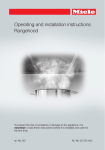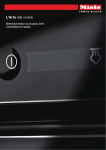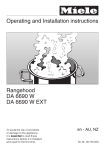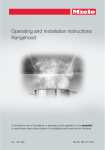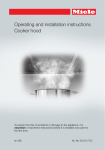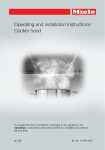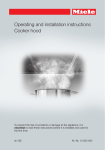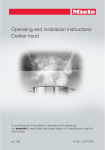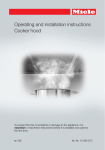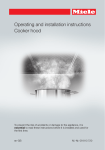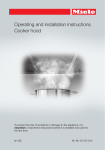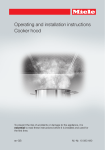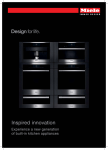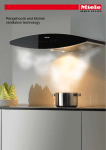Download Miele DA 6700 D Technical data
Transcript
Operating and installation instructions Rangehood To prevent the risk of accidents or damage to the appliance, it is essential to read these instructions before it is installed and used for the first time. en-AU, NZ M.-Nr. 10 185 210 Contents Warning and Safety instructions .......................................................................... 4 Caring for the environment ................................................................................. 11 Description of the functions ............................................................................... 12 Con@ctivity 2.0 function ........................................................................................ 13 Guide to the appliance......................................................................................... 14 Operation (automatic mode) ............................................................................... 16 Cooking with Con@ctivity 2.0 (automatic mode) ................................................... 16 Leaving automatic mode temporarily..................................................................... 18 Returning to automatic mode ................................................................................ 18 Operation (manual mode).................................................................................... 19 Cooking without Con@ctivity 2.0 (manual mode) .................................................. 19 Switching the fan on .............................................................................................. 19 Selecting a power setting ...................................................................................... 19 Selecting the run-on time....................................................................................... 19 Switching the fan off .............................................................................................. 19 Switching the cooktop lighting on/off .................................................................... 20 Power management ............................................................................................... 20 Operation (automatic and manual modes) ........................................................ 21 Operating hours counter ........................................................................................ 21 Altering the operating hours counter for the grease filters ............................... 21 Activating and altering the operating hours counter for the NoSmell active charcoal filter .................................................................................................... 22 Reading the filter operating hours counter ....................................................... 22 Acoustic signal of the touch controls .................................................................... 23 Energy saving tips................................................................................................ 24 Cleaning and care ................................................................................................ 25 Housing.................................................................................................................. 25 Important for appliances with glass surfaces ................................................... 25 Grease filters .......................................................................................................... 26 Resetting the operating hours counter for the grease filters ............................ 27 NoSmell active charcoal filters............................................................................... 28 Resetting the operating hours counter for the charcoal filters ......................... 29 Disposing of the charcoal filters ....................................................................... 29 After sales service and warranty ........................................................................ 30 Position of the data plate ....................................................................................... 30 2 Contents Installation ............................................................................................................ 31 Before installation .................................................................................................. 31 Assembly parts ...................................................................................................... 31 Installation instructions .......................................................................................... 31 Appliance dimensions............................................................................................ 32 Safety distance (S) ................................................................................................. 33 Installation recommendations................................................................................ 34 Electrical connection ........................................................................................... 35 Activating Con@ctivity 2.0 ................................................................................... 36 Installing the Con@ctivity 2.0 dongle..................................................................... 36 Activating Con@ctivity 2.0 ..................................................................................... 36 Activating the rangehood.................................................................................. 36 Activating the cooktop...................................................................................... 37 Activation failed ................................................................................................ 37 Deactivating Con@ctivity 2.0 ................................................................................. 37 Technical data ...................................................................................................... 38 3 Warning and Safety instructions This appliance complies with all relevant local and national safety requirements. Inappropriate use can, however, lead to personal injury and damage to property. To avoid the risk of accidents and damage to the appliance, please read these instructions carefully before using it for the first time. They contain important notes on the safety, installation, use and maintenance of the appliance. Miele cannot be held liable for non-compliance with these instructions. Keep these instructions in a safe place and ensure that all users are familiar with the contents. Pass them on to any future owner of the appliance. Correct application This rangehood is designed for domestic use and for use in similar environments by guests in hotel or motel rooms, bed & breakfasts and other typical living quarters. This does not include common/shared facilities or commercial facilities within hotels, motels or bed & breakfasts. The appliance is not suitable for outdoor use. It must only be used to extract vapours and remove odours from cooking. Any other usage is at the owner's risk. Miele cannot be held liable for damage resulting from incorrect or improper use or operation. Where a recirculation rangehood is fitted above a gas cooktop, please ensure that there is an adequate supply of fresh air into the room in which it is installed. Please seek the advice of a qualified gas fitter if necessary. 4 Warning and Safety instructions This appliance is not intended for use by persons (including children) with reduced physical, sensory or mental capabilities, or lack of experience and knowledge, unless they have been given supervision or instruction concerning its use by a person responsible for their safety, and are able to recognise the dangers of misuse. Safety with children Young children must not be allowed to use this appliance. Older children may only use the appliance when its operation has been clearly explained to them and they are able to use it safely, recognising the dangers of misuse. Cleaning work may only be carried out by older children under the supervision of an adult. Children should be supervised near the appliance. Ensure that they do not play with the appliance. Danger of suffocation! Children may be able to wrap themselves in packing material or pull it over their heads with the risk of suffocation. Keep children away from any packing material. 5 Warning and Safety instructions Technical safety Repairs and other work by unqualified persons could be dangerous. Installation, maintenance work and repairs to electrical appliances must only be carried out by a Miele approved service technician. A damaged appliance can be dangerous. Check it for visible signs of damage. Do not use a damaged appliance. The electrical safety of this appliance can only be guaranteed when continuity is complete between it and an effective earthing system. It is most important that this basic safety requirement is present and tested regularly and, where there is any doubt, the household wiring system should be inspected by a qualified electrician. Reliable and safe operation of this rangehood can only be assured if it has been connected to the mains electricity supply. Before connecting the appliance to the mains supply, ensure that the connection data on the data plate (voltage and frequency) matches the mains electricity supply. This data must correspond in order to avoid the risk of damage to the appliance. Consult a qualified electrician if in any doubt. Do not connect the appliance to the mains electricity supply by a multi-socket unit or an extension lead. Extension leads are a fire hazard and do not guarantee the required safety of the appliance. For safety reasons, this appliance may only be used after it has been built in. This rangehood must not be installed and operated in mobile installations (e.g. on a ship). 6 Warning and Safety instructions Tampering with electrical connections or components and mechanical parts is highly dangerous to the user and can cause operational faults. Only open the housing as described in the instructions given in the installation sheet and in the Cleaning and care section of this booklet. Under no circumstances should any other parts of the housing be opened. The manufacturer's warranty will be invalidated if the appliance is not repaired by a Miele approved service technician. Faulty components must only be replaced by genuine Miele spare parts. The manufacturer can only guarantee the safety of the appliance when Miele replacement parts are used. Do not pull on the mains connection cable. It must not be used for securing other components (such as a shelf). If the mains connection cable is damaged, it must only be replaced by a Miele authorised service technician in order to avoid a hazard. During installation, maintenance and repair work, the appliance must be disconnected from the mains electricity supply. It is only completely isolated from the electricity supply when: – the mains circuit breaker is switched off, or – it is switched off at the wall socket and the plug is withdrawn from the socket. Do not pull the mains connection cable but the mains plug to disconnect your appliance from the mains electricity supply. 7 Warning and Safety instructions Correct use Never use an open flame beneath the rangehood. To avoid the danger of fire, do not flambé or grill over an open flame. When switched on, the rangehood could draw flames into the filter. Fat deposits could ignite, presenting a fire hazard. The rangehood can become damaged when exposed to excessive heat. – When using the rangehood over a gas cooktop, ensure that any burners in use are always covered by a pan. Switch the cooking zone off when a pan is removed, even for a short time. – Select a pan which is suitable for the size of the burner. – Regulate the flame so that it does not burn up the sides of the pan. – Avoid overheating the pan (e.g. when cooking with a wok). Always switch the rangehood on when a cooking zone is in use, otherwise condensation may collect in the rangehood, which could cause corrosion. When cooking with oil or fat, chip pans and deep fat fryers etc., do not leave the pans unattended. Never leave an open grill unattended when grilling. Overheated oil and fat can ignite and could set the rangehood on fire. Do not use the rangehood without the filters in place. This way you will avoid the risk of grease and dirt getting into the appliance and hindering its smooth operation. There is a risk of fire if the rangehood is not cleaned as described in these operating instructions. The rangehood can get very hot during cooking due to heat rising from the cooktop. Do not touch the housing or the grease filters until the rangehood has cooled down. 8 Warning and Safety instructions Correct installation Refer to the cooktop manufacturer's instructions as to whether a rangehood may be operated above the cooktop. Safety regulations prohibit the fitting of a rangehood over solid fuel stoves. Insufficient distance between the cooktop and the rangehood can result in damage to the rangehood. The minimum safety distances between the top of the cooktop and the bottom of the rangehood given in the "Installation" section must be maintained, unless the cooktop manufacturer states that a greater distance is required. If more than one cooking appliance is fitted beneath the rangehood, and they have different minimum safety distances to the rangehood, select the greater distance. The distances given in "Installation" must be observed when fitting the rangehood. 9 Warning and Safety instructions Cleaning and care Do not use a steam cleaning appliance to clean this appliance. The steam could reach electrical components and cause a short circuit. In areas which may be subject to infestation by cockroaches or other vermin, pay particular attention to keeping the machine and its surroundings in a clean condition at all times. Any damage which may be caused by cockroaches or other vermin will not be covered by the machine warranty. Accessories Use only genuine original Miele spare parts. If spare parts or accessories from other manufacturers are used, the warranty will be invalidated, and Miele cannot accept liability. 10 Caring for the environment Disposal of the packing material Disposing of your old appliance The transport and protective packing has been selected from materials which are environmentally friendly for disposal, and can normally be recycled. Electrical and electronic appliances often contain materials which, if handled or disposed of incorrectly, could be potentially hazardous to human health and to the environment. They are, however, essential for the correct functioning of your appliance. Therefore, please do not dispose of your old appliance with your household waste. Recycling the packaging reduces the use of raw materials in the manufacturing process and also reduces the amount of waste in landfill sites. Ensure that any plastic wrappings, bags etc. are disposed of safely and kept out of the reach of babies and young children. Danger of suffocation. Please dispose of it at your local community waste collection / recycling centre. Ensure that your old appliance presents no danger to children while being stored for disposal. 11 Description of the functions Recirculation mode This rangehood operates solely in recirculation mode. The air is drawn in and cleaned first by the grease filters and then by four charcoal filters. The cleaned air is then recirculated back into the kitchen through ventilation grilles in the top of the rangehood. 12 Description of the functions Con@ctivity 2.0 function Automatic control The rangehood has a communication facility which enables the automatic operation of the rangehood depending on the operational state of a Miele electric cooktop. The cooktop transmits information about its operational status via a radio signal to the rangehood. – When the cooktop is switched on, the cooktop lighting on the rangehood comes on independently and, then after a short time, the fan also comes on. – During cooking the rangehood automatically sets the power level according to the number of cooking zones in operation and their power levels. – After switching the cooktop off, the fan and the cooktop lighting will switch off automatically after a specified period of time. For communication to take place, the cooktop must be fitted with an appropriate Con@ctivity 2.0 dongle . See "Operation" for detailed information about this function. Please consult the installation instructions for the Con@ctivity 2.0 dongle to see if connection to your cooktop is possible. In order to be able to use the Con@ctivity 2.0 function, radio contact between the cooktop and the rangehood must be established (see "Activating Con@ctivity 2.0"). 13 Guide to the appliance 14 Guide to the appliance a Suspension cables b Canopy c Grease filter clips d Grease filters e Touch controls The symbols act as touch controls. To select a function, touch the relevant symbol. An audible tone sounds briefly to confirm selection. f Cooktop lighting g Recirculation grilles h Charcoal filters (x 4) i Touch control for switching the fan on and off j Touch control for cooktop lighting k Touch controls for selecting the fan power setting l Touch control for the run-on option m Operating hours control for the grease filters n Operating hours control for the charcoal filters 15 Operation (automatic mode) If Con@ctivity 2.0 is activated, the rangehood always operates in automatic mode (see "Activating Con@ctivity 2.0"). To operate the rangehood manually, see "Cooking without Con@ctivity 2.0 (manual mode)". Cooking with Con@ctivity 2.0 (automatic mode) Switch a cooking zone on at the power setting you want. The rangehood lighting will come on. After a few seconds the fan will come on, first at power setting 2, then it will switch immediately to power setting 1. The rangehood selects the power setting automatically during cooking. This is determined by the total output of the cooktop, i.e. the number of cooking zones in operation and the power settings selected. If you select a higher power setting or are using several cooking zones, the rangehood will switch to a higher power setting. When you reduce the power setting or the number of cooking zones on the cooktop, the rangehood power setting will also be reduced. Examples for power levels 1 to 4 16 Reaction time The rangehood reacts with a slight delay because altering the power setting on the cooktop does not immediately result in a reduction or increase in cooking vapours. Because the cooktop transmits the information to the rangehood at intervals, this can also cause delays. The reaction can vary from a few seconds to a few minutes. Operation (automatic mode) Cooking process Switching off If, for example, you switch on a cooking zone at the highest power setting to heat a pan for frying and reduce the power level after approx. 60 to 90 seconds*, a cooking process is recognised (*60 seconds to 5 minutes for a HiLight cooktop). Switch off all cooking zones. The rangehood switches itself on and when the cooktop power level has been reduced, the rangehood switches to power setting 3 and remains at that level for approx. 5 minutes. – From the Intensive setting IS the fan switches immediately to setting 3. After that the rangehood power setting is determined automatically by the Con@ctivity function. You can select another power setting manually before then. The rangehood fan will reduce its power level over the next few minutes and will eventually switch itself off. This helps to neutralise any lingering vapours and odours in the air. – If the fan is operating at setting 3, it will switch to setting 2 after approx. 1 minute. – From setting 2, the fan switches to setting 1 after 2 minutes. – After 2 minutes at setting 1, the fan switches itself off. – After another 30 seconds, the lighting switches off. The cooking process is then finished. 17 Operation (automatic mode) Leaving automatic mode temporarily To leave automatic mode temporarily during cooking: Manually select a different power setting, or Manually switch the rangehood off, or Activate the run-on option on the rangehood. The fan will switch off after the selected time and the lighting remains switched on. The rangehood functions can now be operated manually (see "Cooking without Con@ctivity 2.0 (manual mode)"). 18 Returning to automatic mode The rangehood returns to automatic mode: if the rangehood has not been used for approx. 5 minutes after selecting a power setting manually, or if the manually selected power setting corresponds to the automatic one again, or if the rangehood fan and the cooktop have been switched off for at least 30 seconds. Automatic mode will resume next time the cooktop is switched on. If you wish to operate the rangehood manually for a complete cooking process, switch on the rangehood fan before switching on the cooktop. If the rangehood and the cooktop have been switched off for at least 30 seconds after cooking, automatic mode will resume the next time the cooktop is switched on. Operation (manual mode) Cooking without Con@ctivity 2.0 (manual mode) The rangehood can be operated manually if: – The Con@ctivity 2.0 function is not activated. – You have temporarily switched off the Con@ctivity 2.0 function (see "Leaving automatic mode temporarily"). Switching the fan on Touch the On/Off touch control The fan will come on at power setting 2. Selecting a power setting For light to heavy cooking vapours and odours, select from power settings 1 to 3. When frying or cooking food with a strong aroma, select the Intensive setting IS. Selecting the run-on time It is advisable to run the fan for a few minutes after cooking has finished to neutralise any lingering vapours and odours in the air. With the run-on function the fan switches itself off automatically after a pre-selected time. After you have finished cooking, touch the run-on option control . – Once: the fan will switch itself off after 5 minutes (5 lights up). – Twice: the fan switches itself off after 15 minutes ( 15 lights up). – If you press the run-on control again, the fan remains on (5 15 goes out). Switching the fan off Press the On/Off touch control to switch the fan off. Select the power setting required by touching a control from 1 to IS. Reducing power on the Intensive setting If power management is activated (preset), the fan will switch to setting 3 after 5 minutes. 19 Operation (manual mode) Switching the cooktop lighting on/off Switching Power management on/off The cooktop lighting can be switched on and off independently of the fan. Touch the run-on option control for approx. 10 seconds, until 1 lights up in the power level display. Touch the cooktop lighting control . Power management The rangehood features a Power management system to help save energy. The fan power setting is reduced and the lighting is switched off automatically. – If the Intensive setting is selected, the fan automatically switches to setting 3 after 5 minutes. – From settings 3, 2 or 1 the power will be reduced by one setting after 2 hours and then in 30-minute stages until the fan finally switches off. – The cooktop lighting will switch off automatically after 12 hours. You can deactivate Power management. This can, however, result in increased electricity consumption. 20 Switch off the fan and the lighting. Then touch in turn, – the lighting control , – then the 1 touch control, and – the lighting control again. If Power management is switched on, the 1 and IS indicators will light up constantly. If it is switched off, 1 and IS will flash. Touch 1 to switch Power management off. The 1 and IS indicators will flash. Touch IS to switch it on. The 1 and IS indicators will light up constantly. Confirm the setting by pressing the run-on control . All the indicator lights will go out. If you don't confirm your selection within 4 minutes, the rangehood will automatically revert to the previous setting. Operation (automatic and manual modes) Operating hours counter The number of hours the appliance has been in operation is stored in memory. Fan power setting indicators 1 to IS show the time set: 1............................................... 20 hours When the grease filter symbol or the charcoal filter symbol lights up, the operating hours counters are signalling that the filters need to be cleaned or changed. Further information about cleaning and changing the filters and resetting the operating hours counter can be found under "Cleaning and care". 2............................................... 30 hours Altering the operating hours counter for the grease filters All the indicator lights will go out. You can set the operating hours counter for the grease filters to suit the type of cooking you do. 3............................................... 40 hours IS ............................................. 50 hours Touch the relevant control to select the duration required. Confirm the selection by touching the grease filter control . If you don't confirm your selection within 4 minutes, the rangehood will automatically revert to the previous setting. It is set at the factory for 30 hours. – Select a shorter time (20 hours) if you fry a lot. – If you only cook occasionally, we recommend that you still select a short time because grease which has built up gradually over a long period of time will harden on the filters and make cleaning more difficult. – If you use very little fat for cooking, select a longer time (40-50 hours). Press the On/Off touch control to switch the fan off. Touch the run-on option control and the grease filter control at the same time. The grease filter symbol and one of the fan power setting indicators will flash. 21 Operation (automatic and manual modes) Activating and altering the operating hours counter for the NoSmell active charcoal filter Charcoal filters are needed for recirculation mode. The operating hours counter for the charcoal filters needs to be activated once and the operating hours counter needs to be set to suit the kind of cooking you do: Press the On/Off touch control to switch the fan off. Touch the run-on option control and the charcoal filter control at the same time. The charcoal filter symbol and one of the fan power settings will flash. Fan power setting indicators 1 to IS show the time set: 1............................................. 120 hours 2............................................. 180 hours 3............................................. 240 hours IS ........................................ Deactivated Touch the relevant control to select the duration required. Confirm the selection by pressing the charcoal filter touch control . All the indicator lights will go out. If you don't confirm your selection within 4 minutes, the rangehood will automatically revert to the previous setting. 22 Reading the filter operating hours counter To check the percentage of time set already used: Press the On/Off touch control to switch the fan on. Press and hold the grease filter control or the charcoal filter control . One or more of the fan power setting indicators will flash. The number of flashing indicators shows the percentage of the operating time which has already been used up. Indicator 1 .................................... 25 % Indicators 1 and 2 ........................ 50 % Indicators 1 to 3 ........................... 75 % Indicators 1 to IS ........................ 100 % The number of operating hours used remains in the memory even when the appliance is switched off or there is a power cut. Operation (automatic and manual modes) Acoustic signal of the touch controls When selecting a function with the touch controls, an acoustic signal will sound for confirmation. The acoustic signal can be deactivated. Press the On/Off touch control to switch the fan off. Touch the IS and the grease filter controls at the same time for approx. 5 seconds until a short acoustic signal is heard. The acoustic signal function is now switched off. To reactivate the acoustic signal, follow the steps as per deactivating the signal. When power is restored to the rangehood after it has been disconnected from the mains electricity supply or after a power cut, the acoustic signal will be activated again, regardless of the previous setting. 23 Energy saving tips This rangehood operates very efficiently and economically. The following will help you to save even more energy when using it: – Ensure there is sufficient ventilation in the kitchen when cooking. – Always cook with the lowest possible setting. This produces fewer cooking vapours, so you can use a lower rangehood power level and therefore benefit from reduced energy consumption. – Use the Con@ctivity function. The rangehood will switch on and off automatically at the optimum power level for the cooking you are doing, which ensures low energy consumption. – If you are operating the rangehood manually, please note the following: – Check the power level selected on the rangehood. A lower power level is generally sufficient for the majority of cooking. Only use the intensive setting when necessary. – When a large volume of cooking vapours are being produced, switch to a high power level in good time. This is more efficient than operating the rangehood for longer to try to capture cooking vapours which have already been distributed throughout the kitchen. – Make sure that you switch the rangehood off after use. If cooking vapours and odours still need to be removed from the kitchen air after cooking, use the 24 run-on function. The fan will switch off automatically after the selected run-on time. – Clean or change the filters at regular intervals. Heavily soiled filters reduce performance, increase the risk of fire and are unhygienic. Cleaning and care Housing General The surfaces and controls are susceptible to scratches and abrasion. Please observe the following cleaning instructions. All external surfaces and controls can be cleaned using warm water with a small amount of washing-up liquid applied with a well wrung-out soft sponge or cloth. After cleaning, wipe the surfaces dry using a soft cloth. Do not use: – cleaning agents containing soda, acids, chlorides or solvents, – abrasive cleaning agents, e.g. powder cleaners or cream cleaners and abrasive sponges, as well as pot scourers or sponges which have been used previously with abrasive cleaning agents. These will damage the surface material. Important for appliances with stainless steel surfaces Stainless steel surfaces can be cleaned with a proprietary nonabrasive cleaning agent designed specifically for use on stainless steel, e.g. Original Miele ceramic and stainless steel cooktop cleaner. To help prevent re-soiling, a proprietary conditioning agent for stainless steel (Original Miele Care product for stainless steel) can also be used. Follow the manufacturer’s instructions on the packaging. Apply sparingly with a soft cloth following the instructions on the packaging. Important for appliances with lacquered housing Observe the general notes on cleaning earlier in this section. It is very difficult to clean this type of surface without causing minor marks to the surface material. This can become particularly noticeable if there is halogen lighting in the kitchen. Important for appliances with glass surfaces Glass surfaces can be cleaned using a proprietary non-abrasive cleaning agent designed specifically for use on glass. 25 Cleaning and care Grease filters The re-usable metal grease filters in the appliance remove solid particles (grease, dust, etc.) from the kitchen vapours, preventing soiling of the rangehood. An oversaturated filter is a fire hazard. When to clean the grease filters The grease filters should be cleaned regularly (at least every 3-4 weeks) to avoid a build-up of grease. Clean them immediately if the grease filter operating hours control lights up. You can set the operating hours counter for the grease filter to suit the type of cooking you do (see "Operation"). Removing a grease filter The grease filter can fall out when you are handling it. This can result in damage to the filter and the cooktop below. Make sure you hold the filter securely at all times when handling it. To take out a grease filter, release the locking clip on the filter, lower the filter approx. 45°, unhook it at the back and remove it. Cleaning the grease filters by hand Clean the filters with a soft nylon brush in a mild solution of hot water and a small amount of washing-up liquid. Do not use undiluted washing up liquid. Unsuitable cleaning agents Unsuitable cleaning agents can cause damage to the surface of the filters if used regularly. Do not use: – cleaning agents containing descaling agents, – powder cleaners or cream cleaners, – aggressive all-purpose cleaning agents or spray cleaners for grease, – oven sprays. 26 Cleaning and care Cleaning the grease filters in a dishwasher Place the filters as upright as possible in the lower basket, with the short sides upright, ensuring the spray arm is not obstructed. If a grease filter is inadvertently refitted upside down, insert a small screwdriver blade into the slit to disengage the clip. Resetting the operating hours counter for the grease filters Use a proprietary household dishwasher detergent. After cleaning, the operating hours counter needs to be reset. Select a dishwasher programme with a wash temperature between 50 °C and 65 °C. Whilst the fan is switched on, touch the grease filter control for approx. 3 seconds, until only the 1 is flashing. Depending on the cleaning agent used, cleaning the filters in a dishwasher can cause permanent discolouration to the surface. However, this will not affect the functioning of the filters in any way. After cleaning The grease filter symbol goes out. If the grease filters are cleaned before the operating hours counter has reached its maximum, Touch the grease filter control for approx. 6 seconds, until only the 1 is flashing. After cleaning, leave the filters to dry on an absorbent surface before refitting them. When removing the filters for cleaning, also clean off any residues of oil or fat from the now accessible housing to prevent the risk of these catching fire. Replace the grease filters, making sure that the locking clips are facing down towards the cooktop. 27 Cleaning and care NoSmell active charcoal filters With recirculation mode, four charcoal filters must be fitted in addition to the grease filters. These are designed to absorb cooking odours. They are fitted into the canopy from above. Replacement charcoal filters can be obtained from Miele or via the internet at www.miele-shop.com. See the back of these instructions for contact details, and "Technical data" for type and reference number. Fitting and replacing the charcoal filters Before fitting or replacing the charcoal filters, the grease filters must first be taken out (see previous section for instructions on how to do this). Unwrap the charcoal filters. When fitting or removing the charcoal filters, ensure the surface upon which you are standing is stable and not prone to slippage. Open the holders for the charcoal filters by pushing upwards on the yellow handles. Insert the charcoal filters and close the holders. Refit the grease filters. When fitting for the first time, activate the operating hours counter (see "Operation"). 28 Cleaning and care When to change the NoSmell active charcoal filters Always replace the charcoal filters when they no longer absorb kitchen odours effectively. They should, however, be replaced at least every 2 years. The charcoal filter operating hours counter will light up to remind you to change the charcoal filters regularly. The charcoal filter operating hours counter needs to be activated before using for the first time (see "Operation"). Resetting the operating hours counter for the charcoal filters After changing the charcoal filters, the operating hours counter needs to be reset. Touch the charcoal filter control for approx. 3 seconds with the rangehood switched on until only the indicator light for fan power setting 1 is flashing. The charcoal filter symbol will go out. If you replace the charcoal filters before the operating hours counter has reached its maximum: Touch the charcoal filter control for approx. 6 seconds until only the indicator light for fan power setting 1 is flashing. Disposing of the charcoal filters The used charcoal filters can be disposed of with the normal household waste. 29 After sales service and warranty In the event of a fault which you cannot remedy yourself, please contact Miele. The contact details for Miele are given at the back of these instructions. When contacting Miele, please quote the model and serial number of your appliance. These can be found on the data plate. Position of the data plate The data plate is visible after removing the grease filters. Warranty The manufacturer's warranty for this appliance is 2 years. For further information, please refer to your warranty booklet. 30 Installation Before installation Before installation, it is important to read the information given on the following pages as well as the "Warning and Safety instructions" at the beginning of this booklet. Assembly parts 4 screws 5 x 60 mm and 4 plugs 8 x 50 mm For securing the appliance to the ceiling. The screws and plugs are suitable for use in concrete ceilings only. For other types of ceiling construction, alternative fixings will be required. Make sure the ceiling is able to take the weight of the rangehood (see "Technical data"). 4 sets of ceiling fixings For suspending the rangehood, comprising 4 suspension cables, 4 housing fixings and 4 ceiling fixings. The wire cables must not be used to secure additional components (e.g. an interim shelf). 3 cable clamps For securing the mains connection cable to one of the suspension cables. 1 cable guide For securing the mains connection cable to one of the ceiling fixings. Drilling template One of the cardboard inserts serves as the drilling template. Installation instructions See enclosed installation sheet for instructions on how to install this appliance. 31 Installation Appliance dimensions 32 Installation a Mains connection cable Safety distance (S) The minimum distances between the top of a cooktop (excluding trivets, dials depending on model) and the bottom of the rangehood are as follows, unless a greater distance is specified by the manufacturer of your cooking appliance. See also "Warning and Safety instructions". Cooking appliance Minimum distance S Electric cooktop 600 mm Electric grill, deep fat fryer (electric) 650 mm Multi-burner gas cooktop with maximum 45.4 MJ/h total output, with no burner having a greater output than 16.2 MJ/h. 650 mm Multi-burner gas cooktop with total output greater than 45.4 MJ/h, but with a maximum of 77.8 MJ/h, with no burner having a greater output than 17.3 MJ/h. 760 mm Multi-burner gas cooktop with total output greater than 77.8 MJ/h, with a single burner having a greater output than 17.3 MJ/h. Not possible Single burner gas cooktop with a maximum output of 21.6 MJ/h. 650 mm Single burner gas cooktop with an output greater than 21.6 MJ/h, but with a maximum of 29.2 MJ/h. 760 mm Single burner gas cooktop with an output greater than 29.2 MJ/h. Not possible 33 Installation Installation recommendations – When deciding on the safety distance between the cooktop and rangehood, please note that a distance of 650 mm above electric cooktops may be preferable to give more working space under the rangehood. – Account should also be taken of the height of the person who will be using the rangehood most often. They should have sufficient space to work comfortably at the cooktop, and be able to reach the rangehood controls with ease. – If positioned too high, extraction will be inefficient. – Ensure there is sufficient room above the recirculation grilles to allow air to be expelled unhindered. A distance of at least 300 mm must be maintained between the top of the rangehood and the ceiling or any furniture units installed above the appliance. – To achieve optimum vapour extraction, the rangehood must cover the cooktop. It should be positioned centrally over the cooktop, not to the side or to the rear. – The cooktop should be no wider than the rangehood and, if possible, it should be narrower, especially for safety distances greater than 750 mm. – The installation area must be easily accessible. The rangehood should be easily accessible and easy to dismantle in the event that service is required. This should be taken into 34 consideration when planning the position of cupboards, shelves, ceilings or features in the vicinity of the rangehood. Electrical connection Installation, repairs and other work by unqualified persons could be dangerous. The manufacturer cannot be held liable for unauthorised work. All electrical work should be undertaken by a suitably qualified and competent person in strict accordance with current national and local safety and building code regulations. Ensure power is not supplied to the appliance until after installation or repair work has been carried out. The wires in the mains lead are coloured in accordance with the following code: Green/Yellow .............................earth Blue ........................................neutral (N) Brown .........................................live (L1) The rangehood must be connected to a mains connection which complies with current local and national safety regulations. For extra safety, it is advisable to install a residual current device (RCD), with a trip current of 30 mA. Contact a qualified electrician for advice. Connection of this appliance should be made via a suitable isolator which complies with national and local safety regulations. When switched off, there must be an all-pole contact gap of 3 mm in the switch (including switch, fuses and relays according to EN 60335). The connection data is given on the data plate (See "After sales service and warranty"). Ensure that this data matches the household mains supply. 35 Activating Con@ctivity 2.0 Installing the Con@ctivity 2.0 dongle In order for the Con@ctivity 2.0 function to be used, the cooktop must be fitted with the Con@ctivity dongle. Please read the instructions for the Con@ctivity 2.0 dongle before installation. Activating the rangehood The cooktop and rangehood must be switched off. Touch the run-on option control 515 for approx. 10 seconds, until 1 lights up in the fan power setting display. Then touch in turn, Activating Con@ctivity 2.0 – the 1 control, In order to use the Con@ctivity 2.0 function, radio contact between the cooktop and the rangehood must be activated. – then the lighting control . Both appliances must be installed and operational. Wireless connection must be activated on the rangehood and the cooktop at the same time. Activation on the rangehood is described below. Activation on the cooktop is described in the relevant Operating instructions. Please refer to the Operating instructions before starting. Activate the rangehood first, then the cooktop. – then the IS control, The rangehood is now in signing on/off mode. If a wireless connection has not yet been established, 2 and 3 will flash at the same time. If a wireless connection has already been established, 2 and 3 will light up constantly (Con@ctivity 2.0 is already activated or a remote control is signed on). Touch the IS control to activate Con@ctivity 2.0. The search for a signal will start. Meanwhile, start the activation of the cooktop. 36 Activating Con@ctivity 2.0 Activating the cooktop Activation failed While the rangehood is searching for the radio connection, start activating the cooktop. More information about this can be found in the Operating instructions for the cooktop. If connection cannot be established despite activating the Con@ctivity function on the rangehood and cooktop, the function must be deactivated on both appliances and then the procedure repeated. When the cooktop registers that connection has been established, confirm activation on the rangehood with the run-on option control 515. All indicators will go out. Deactivating Con@ctivity 2.0 Confirm the activation on the cooktop. The Con@ctivity 2.0 function can now be used. If you do not confirm your selection within 4 minutes, activation will not take place. Deactivation on the rangehood is carried out in the same way as activation, by selecting the 1 control instead of IS. To deactivate the cooktop, please refer to the Operating instructions supplied with it. Please bear in mind that disabling the signal will also disable any remote control function and this will have to be activated again. You only need to carry out the activation procedure once. If the appliances are disconnected from the electricity supply, during a power cut for example, they will still remain activated. 37 Technical data Fan motor 2 x 72 W Cooktop lighting 4x3W Total rated load 156 W Voltage Fuse rating AC 230 V 10 A Mains connection cable length 1.8 m Weight 33 kg Recirculation mode with charcoal filters DKF 21 38 Technical data Data sheet for domestic cooker hoods In acc. with delegated regulation (EU) No. 65/2014 and regulation (EU) No. 66/2014 MIELE Model name / identifier DA 6700 D Annual Energy Consumption (AEChood) 80,6 kWh/year Energy efficiency class A+ (most efficient) to F (least efficient) C Energy efficiency index (EEIhood) 83,8 Fluid Dynamic Efficiency (FDEhood) 15,1 Fluid Dynamic Efficiency class A (most efficient) to G (least efficient) D Lighting Efficiency (LEhood) 40,0 lx/W Lighting Efficiency class A (most efficient) to G (least efficient) A Grease Filtering Efficiency 91,2 % Grease Filtering Efficiency class A (most efficient) to G (least efficient) B Airflow at best efficiency point 310,6 m3/h Air flow (min. speed) 250 m3/h Air flow (max. speed) 450 m3/h Air flow (intensive or boost setting) 600 m3/h Max. air flow (Qmax) 600 m3/h Air pressure at best efficiency point 236 Pa Airborne acoustical A-weighted sound power emissions (min. speed) 54 dB Airborne acoustical A-weighted sound power emissions (max. speed) 67 dB Airborne acoustical A-weighted sound power emissions (intensive or boost setting) 74 dB Electrical power input at best efficiency point 135,0 W Power consumption in off mode (Po) W Power consumption in standby mode (Ps) 0,15 W Nominal power of lighting system 12,0 W Average illumination of the lighting system on the cooking surface 480 Ix Time increase factor 1,5 39 Miele Australia Pty. Ltd. ACN 005 635 398 ABN 96 005 635 398 Miele Center and Head Office Melbourne: 1 Gilbert Park Drive Knoxfield, VIC 3180 Miele Center and Office Melbourne: 206-210 Coventry Street South Melbourne, VIC 3205 Miele Center and Office Sydney: 3 Skyline Place Frenchs Forest, NSW 2086 Miele Center and Office Brisbane: 39 Harvey Street North Eagle Farm, QLD 4009 Miele Center and Office Adelaide: 83-85 Sir Donald Bradman Drive Hilton, SA 5033 Miele Center and Office Perth: 205-207 Stirling Highway Claremont, WA 6010 Miele New Zealand Limited IRD 98 463 631 Head Office: Level 2, 10 College Hill Freemans Bay, Auckland 1011 Miele Center Auckland: 8 College Hill Freemans Bay, Auckland 1011 Telephone: 0800 4 MIELE (0800 464 353) www.miele.co.nz www.miele.com.au Miele Global Headquarters Germany Miele & Cie. KG Carl-Miele-Straße 29 33332 Gütersloh Federal Republic of Germany 40 DA 6700 D en-AU, NZ M.-Nr. 10 185 210 / 00












































